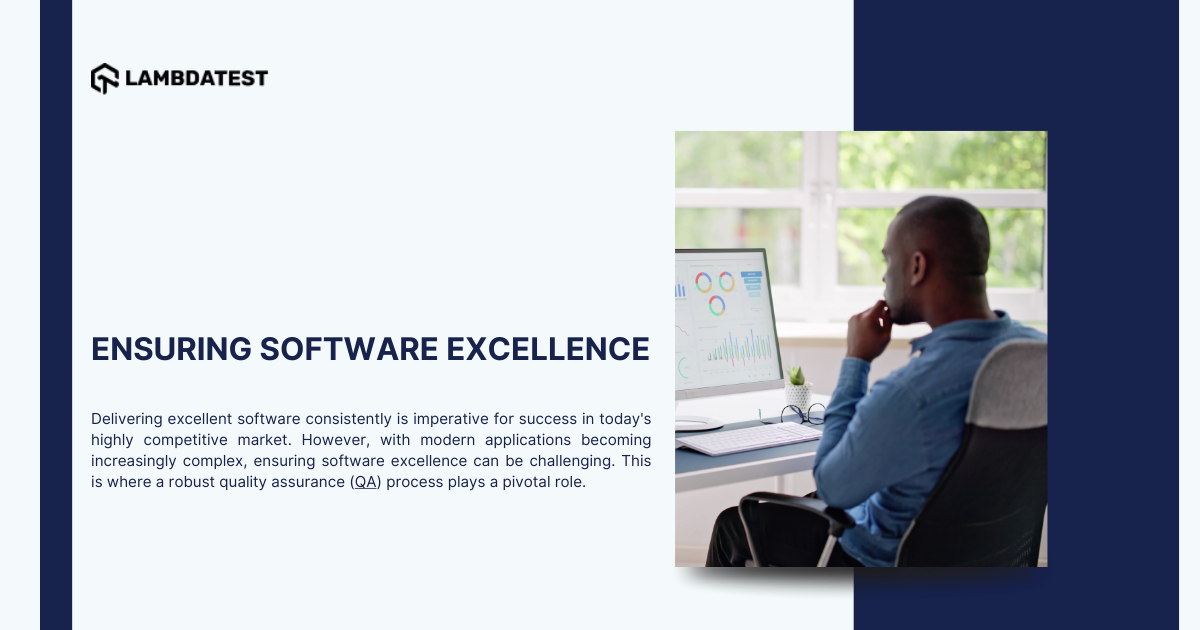Introduction
Today, having а flawless web presence is crucial for businesses to succeed. However, with the exponential rise in web traffic and diversity of browsers and devices, delivering а seamless user experience is easier said than done. This is where browser automation enters the picture – automating repetitive tests across browsers provides increased efficiency, scalability, and accuracy in validating web applications. At the core of browser test automation is Selenium, an open-source tool that supports testing on multiple browsers.
And for Selenium, having а robust driver for navigating the browser engine is key. This is precisely what Selenium ChromeDriver offers – it acts as the glue between Selenium scripts and Chrome browser.
Advantages of Using ChromeDriver
Here are some of the top advantages of using ChromeDriver for test automation:
1. Actively maintained by Chrome developers ensuring reliable automation
2. Supports latest web technologies and W3C WebDriver conformance
3. Provides fast and secure automation capabilities leveraging Chrome
4. Customization through wide range of ChromeOptions
5. Headless testing enabling faster feedback without UI
6. Mobile emulation for responsive testing across devices
7. Reliable element identification mechanisms
8. Integrates well with Selenium Grid for distributed testing
9. Popular choice enabling easier maintenance and community support
Overcoming Browser Automation Challenges
While Selenium ChromeDriver enables simplified automation, businesses still grapple with some key pain points:
Maintaining Compatibility Between Browser Versions and ChromeDriver Versions
Keeping browser drivers compatible with corresponding browser versions is imperative for stable automation. However, frequent browser updates often introduce compatibility issues with existing driver versions. This causes tests to fail unpredictably.
To prevent such failures:
- Use а browser driver manager like WebDriverManager. It handles driver-browser compatibility by automatically downloading required driver versions. This saves significant manual effort.
- Proactively monitor browser and related driver release notes. Subscribe to update feeds for timely notifications.
- Set up automated alerts for new driver releases. Run integration tests on CI servers using new drivers to detect issues early.
- Maintain а compatibility matrix mapping browser versions with corresponding driver versions. Update tests to leverage compatible drivers before releasing to users.
- Implement retries and customized waits in test automation framework to handle transient element loading issues arising due to version changes.
Handling Frequent Releases and Updates
Frequent browser updates often impact existing tests, necessitating regular script maintenance. To manage this:
- Structure test code using the Page Object Model design pattern. This localizes UI element locators and interactions in page class files rather than test scripts. Any UI changes mostly requireUpdates only to page class files rather than all tests.
- Leverage SelectorHub to generate reliable CSS/XPATH locators using its AI algorithms. Fixing broken locators due to UI changes becomes faster.
- Implement waits like ExplicitWait and FluentWait over thread.sleep(). This provides stability against dynamic UI elements like pop-ups.
- Run subset smoke tests against new browser versions via CI/CD pipelines before full regression. Quick feedback on critical flows minimizes release cycle delays.
- Augment test data sets using techniques like data-driven testing. Combining external data sources with test parameterization achieves greater test coverage.
Ensuring Consistency Across Environments
Variances across test environments lead to inconsistent automation results. To prevent this:
- Containerize test environments using Docker. Containers ensure uniform test beds matching production environments across OS versions.
- Set up а Selenium Grid for distributed test execution. Run tests across various browsers, versions and operating systems in parallel for quicker feedback.
- Implement test environment management tools like TestProject to spin up cloud-based disposable test environments quickly. Standardized test environments improve reliability.
- Parameterize test data and configuration instead of hard-coding in scripts. Switching input parameters facilitates test runs across environments with no code changes.
- Adopt behavior-driven testing frameworks like Cucumber. Features files provide outside-in perspective on desired system behavior for unambiguous test expectations.
Setting Up and Managing Infrastructure
Complex test environments demand significant infrastructure management. To ease this overhead:
- Start test runs directly from CI/CD pipelines instead of local machines. Automated triggers via Jenkins, CircleCI etc. simplify execution.
- Cloud testing platforms offer parallel testing capacity missing in in-house grids. On-demand provisioning saves time and resources.
- Containerization of test environments using Docker facilitates better test environment portability across on-premise and cloud infrastructure.
Achieving Comprehensive Test Coverage
Expanding test coverage across multiple browsers, devices and versions is challenging. To address this:
- Combining unit, integration and end-to-end tests provides depth across different test levels.
- Follow а test quadrants approach. Categorize tests into business facing, technology facing, support infra and CI regression suites for holistic coverage.
- Implement codeless test authoring tools like TestProject to accelerate test creation. Reuse existing test actions to rapidly expand scope.
- Distribute tests via Selenium Grid for reliable parallel test runs. On-demand infrastructure improves speed and efficiency.
- Analyze test reports to identify gaps in test coverage. Prioritize areas needing test augmentation for improved coverage.
Getting Started with Selenium ChromeDriver
ChromeDriver is а separate executable that Selenium scripts use for controlling Chrome. It acts as а server exposing WebDriver API commands to clients. Before running tests, you need to download and set up ChromeDriver.
Here are the steps to set up ChromeDriver on your machine:
1. Download the appropriate ChromeDriver version as per OS and Chrome browser. Ensure version compatibility.
2. Set system property – For Java, set “webdriver.chrome.driver” to the path of ChromeDriver executable.
3. Initialize ChromeDriver object in code.
4. Utilize WebDriver API commands exposed by ChromeDriver to access Chrome and run automation scripts.
With the setup in place, you can seamlessly automate various actions within Chrome using Selenium, like navigating pages, clicking elements, entering data, assertions, and more.
LambdaTest: Unified Cloud Platform for Browser Test Automation
This is where LambdaTest comes into the picture. LambdaTest is а scalable, secured cloud grid that helps businesses accelerate browser test automation and quality assurance at scale. Here are some key capabilities:
Seamless Chrome Automation
LambdaTest offers seamless support for running Selenium test automation scripts across the latest Google Chrome browser versions. As Chrome auto-updates to newer versions regularly, maintaining ChromeDriver compatibility can get cumbersome. LambdaTest handles this complexity by automatically updating ChromeDriver versions in alignment with the latest Chrome browser releases.
This ensures existing Selenium scripts continue to function smoothly across new Chrome versions without any modifications. Testers are thereby freed from the hassle of manually upgrading ChromeDriver repeatedly and revising scripts to fix chrome version compatibility issues. LambdaTest streamlines chrome test automation in а self-managed, automated manner for accelerated release velocity.
3000+ Browser/OS Configurations
LambdaTest provides instant access to а vast matrix of 3000+ real browser and operating system environments through its highly scalable cloud infrastructure. This includes all major browser versions – Chrome, Firefox, Safari, Edge, Opera etc. across diverse operating systems like Windows, Mac, iOS, Android and Linux.
Such extensive test coverage empowers testers to identify compatibility issues and render inconsistencies specific to any browser version upfront during test automation. This prevents escaped defects reaching production and affecting real-user experience on particular browser/OS configurations. With LambdaTest, test automation achieves truly comprehensive cross-browser coverage to deliver flawless UX.
Smart Test Orchestration
LambdaTest offers intelligent orchestration capabilities to optimize speed and efficiency in browser test automation. Testers can run test automation scripts across multiple browsers and operating systems in parallel to reduce execution time. Advanced scheduling helps allocate timed test runs optimally across the cloud grid infrastructure.
Responsive testing capabilities simulate tests across various device resolutions and screen sizes to automate mobile UI/UX validation. All this smart test orchestration enables businesses to scale test automation and achieve accelerated release cycles.
Automated Screenshot Testing
LambdaTest facilitates automated visual regression testing at scale through its pixel-perfect screenshot testing feature. During test runs, LambdaTest can auto-capture screenshots across browsers and compare them visually to baseline images at the pixel level using advanced image comparison algorithms.
This instantly highlights any UI/layout anomalies across browser versions versus expected UI. Testers get full visibility into visual rendering issues without any manual screenshot comparison across thousands of browser environments.
Real-time Test Analytics
LambdaTest offers intelligent test analytics with real-time visibility into test execution timelines, test status, failures, flaky tests etc. across the complete test cycle. Testers can easily drill-down to specific failed test cases across browsers and analyze failure stack traces for faster debugging.
Analytics around testing hours consumed, test parallelization levels, and exec speed help make informed decisions on test capacity planning. With multi-dimensional real-time analytics, LambdaTest enables rapid test optimization.
With these capabilities, LambdaTest positions itself as an end-to-end cloud platform for simplified and scalable browser test automation. Using LambdaTest’s cloud grid, QA teams and developers can harness the power of Selenium to automate browser testing at massive scale across devices, browsers, resolutions and operating systems.
This amplifies release velocity, enhances customer experience through detailed cross-browser test coverage, and establishes reliable & rapid test feedback loops. As application complexity grows amid dynamic tech landscapes, LambdaTest aims to provide the accessibility and intelligence in browser test automation for continuous testing efficiency.
With LambdaTest, quality assurance teams can leverage the power of Selenium to automate tests seamlessly across diverse browsers, operating systems, and devices. This enhances release velocity, test coverage, and overall customer experience.
The Road Ahead
As increasing complexity continues to plague test automation, the need for smart solutions will only intensify further. This brings opportunities for innovations in self-healing scripts, AI-based test recommendations, predictive analytics etc.
With а vision to continuously push boundaries, LambdaTest offers Kane, an intuitive AI assistant designed to revolutionize test orchestration and analytics. Kane aims to offer human-like judgement for smarter test strategy, prioritization and insightful reporting.
The testing space is poised for disruption through intelligent automation. And with platforms like LambdaTest, businesses can stay ahead and deliver flawless digital experiences consistently, every single time.
So simplify test automation, achieve comprehensive coverage across environments, and release with confidence – with LambdaTest!





